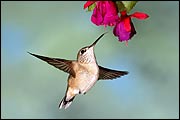Of hummingbirds and immigrants
'Hummingbirds migrate north and south just like we do. They are our kin.'
After my father lost his job, he told us that we would move to the United States. Mexico had been in an economic crisis for most of the 1980s, so there were no job prospects for him. I began my first year of junior high in the United States. I forgot about the hummingbirds.
Texas meets Mexico along the Rio Grande from El Paso all the way to the Gulf of Mexico. I’ve lost count how often I’ve crossed this river. My family would cross it as we visited Mexico every winter break and sometimes over the summer. The car trips lasted for days, but I knew not to complain. My father would point out how each Mexican city was growing larger. Queretaro, Zacatecas, Aguascalientes, Monterrey, and Chihuahua were surrounded by swelling expanses of cinderblock houses and unpaved roads as far as the eye could see. In the countryside, however, we started to see ruined houses: Their owners had left for the cities or for the United States. One year I heard that Mexico could no longer feed itself and had to import its food from the United States, yet I saw fields that were fallow and covered with trash, so I couldn’t understand why.
When I went to graduate school in Alabama, I rediscovered hummingbirds. I spent many hours in outdoor gardens studying, and they would often be my companions. I learned that millions of ruby-throated hummingbirds migrate from Central America to the eastern United States and back every year. So arduous is the journey over the Gulf of Mexico that many do not make it. It is a real source of wonder to me that a bird that weighs less than a nickel can cross more than 500 miles of open water overnight. Wherever they go they provide an economic service by pollinating plants. There are plenty of flowers that need servicing, so we don’t complain that they are taking jobs away from bumblebees.
“Look to the hummingbirds,” I once told a group of Latina and Latino student activists. “They migrate north and south just like we do. When timber companies clear their wintering forests, they become dislocated just like us. They are our kin.” I also reminded them of the Aztec belief that hummingbirds are the souls of men who died in battle and women who died in childbirth. These are the hummingbirds that pollinate flowers in the United States every summer.
Big Bend National Park is on the U.S. side of the Rio Grande Valley in Texas. On a camping trip a friend and I followed a trail along the sand bank of a canyon. On the Mexican side we could see a small rural town in the distance, a reminder that not only did the national park stop at the river, but that a whole different civilization began just a few yards away.
On the bank where the trail ended were the remains of a campfire. Some torn polyester pants, a dirty pair of socks, and some cans of food were left behind. Other tourists walked by. A girl pointed out the campsite to her mom who urged her on, clearly embarrassed that her daughter had to see that a Mexican immigrant had earlier crossed the river. Coming back from the trail I turned to see the sunset over the escarpment of a mountain range and the vast, overwhelming expanse of the desert. There in the night a human being was going to try to make it north. It would be 80 miles before he would find the next town. Perhaps he never made it.
That summer more than 300 human remains of immigrants were found in the Texas desert.
Since I first started traveling over the Rio Grande more than 10 million Mexicans have crossed the border without documents in search of work in the United States. Probably millions more have crossed and returned to Mexico.
Immigration is driven by powerful forces of human need. Something is not right in Central America and Mexico. It hasn’t been right for decades. People are hungry. They despair at the possibility of becoming even poorer. And so, there in the desert night, they become hummingbirds.
Hummingbirds know to move on whenever the land no longer hosts the precious flowers that support them. For 2 million years human beings have done the same. It is a recent idea that people must remain in one place for all time, but many places cannot support all the human life in them anymore.
The worldwide movement for immigrant rights is the movement to defend a people’s right to exist. To defend the immigrant’s right to exist one must also defend the immigrant’s right to work. Work that is well done feeds the soul and binds one to a place and a community. Work that is well paid brings dignity to the worker and the employer. I see many immigrants who understand that their much-needed work ennobles them and gives them a sense of belonging to our community.
The powerful demand documentation, so the worker must provide an ID card, a visa, and a Social Security number. But the soul has its own documentation: roads paved, houses built, children fed, fields harvested, and flowers grown. The work that immigrants do makes our life of plenty possible. The wealth we accumulate with the privileges we have allows us to cultivate ourselves as well as our families and communities—but for our souls to be whole we must recognize the signs of those other souls in their labor.
The powerful proclaim that immigration is making us lose control of the country. They use the language of fear and breakdown. But the idea of border control is and always has been a fantasy. In the expanse of North America there is a biological ecology as well as an ecology of the human spirit that does not follow treaties and official demarcations. We forget, but the land itself remembers.
The cliffs of Seminole Canyon near the Rio Grande have served as a refuge for human beings since the last Ice Age. The Rio Grande Valley has been a human migration route for at least 12,000 years. Humans migrated north and south as the seasons or the climate changed. It was a migration route south when the civilizations in central Mexico flourished and a migration route north when they collapsed. It will remain a migration route long after the names of those men in wool suits a thousand miles away, who think they can control millions of people with an ink pen, are forgotten. The cliff walls of Seminole Canyon preserve the documentation of those who have made the journey for thousands of years: rock paintings of human beings with wings.
My great-grandmother was a Zapotec Indian from the Mexican state of Oaxaca. In the Zapotec language the word for poetry is guie’ sti’ diidxazá, which means literally “the flower-word.” Flowers are a metaphor for the soul in the cultures of southern Mexico. The flower-word is not everyday speech nor the product of an intellectual exercise but speech that emerges from a truth felt deeply. The wisdom traditions of those cultures affirm that the flower-word cannot die even as those who speak it today pass away. This is because the flower-word is rooted deep in the past and in the earth. Those who are in power now cannot uproot it no matter how hard they try. This is as much a spiritual manifesto as a challenge to the forces of globalization.
The flower-word is that source of meaning that a community can draw upon for its strength. It predates us and will exist long after our own death. Knowing this has given me faith that my participation in the life of the community, at whatever level I can offer and wherever I may be, matters and has a consequence that even I cannot measure. All of us who speak to the powerful on behalf of freedom are indeed warrior-mothers: hummingbirds that sparkle with iridescence even in a world of asphalt and concrete. We are hummingbirds that cannot stay in one place and must search everywhere for the flowers of deep wisdom before our next great journey.
See sidebar for links to related resources.








